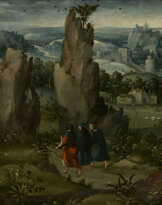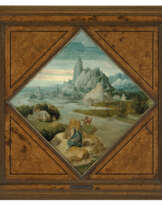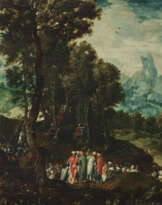ID 842432
Lot 601 | Herri met de Bles
Estimate value
€ 50 000 – 80 000
1534? Dinant - 1584 Ferrara
Title: Mountain Landscape with Scenes from the Life of John the Baptist.
Technique: Oil on wood.
Mounting: Parquetted.
Measurement: 75 x 62,5cm.
Frame: Framed.
Literature:
L. Serck, Henri Bles & la peinture de paysage dans les Pays-Bas méridionaux avant Bruegel, p. 329-338, Löwen 1990, in preparation.
Provenance:
Auction Sotheby's, London, 08.07.1981, Lot. 34 (as Herri met de Bles);
Auction Sotheby's, London, 21.08.1982, Lot. 52 (as Herri met de Bles);
Auction Hotel de Ventes de Geneve, Geneva, 01.10.2008, Lot. 1378 (as Herri met de Bles);
Private ownership, Panama.
Herri Met de Bles, also known as Herry de Patinir or "il Civetta", was a Flemish painter active in Antwerp in the first half of the 16th century and probably in Italy, where he died (most likely in Ferrara).
There is little certain knowledge about his biography, and most of his works are neither signed nor dated, so his life remains a mystery. Because of his signature in the form of an owl over a tree, he was nicknamed "il Civetta" in Italy, where his works were much sought after by collectors.
He may have been the grandson of another Flemish landscape painter, Joachim Patinir. What is certain is that he was admitted as a master to the St. Luke's Guild in Antwerp in 1535 under the name "Herry de Patinir", which underlines his affiliation to the Patinir family. The most likely hypothesis seems to be that of Met de Bles' artistic training in Joachim's workshop, since the style and the "lyrical" feeling towards the depiction of nature coincide.
Herri met de Bles was a specialist in landscapes and painted many works with religious themes, often combining these two genres in a successful way. Among the painter's favourite motifs, repeated several times and with many variations, are: The Flight into Egypt, Landscape with the Sacrifice of Isaac, Landscape with the Sermon of John the Baptist, Landscape with the Conversion of Paul on the Road to Damascus, Earthly Paradise, and Landscape with the Last Supper at Emmaus.
The present work shows three episodes from the life of John the Baptist, combined in the manner of earlier Flemish painting, which depicted various stations of the Stations of the Cross or episodes from the lives of the saints in a single painting. In the centre we see the saint seated with a book in his left hand, his right hand raised to signify the blessing of the animals. At his sides appear the Baptism of Christ and the Annunciation to the Gentiles.
The proclamation and blessing of animals has no prominent counterpart in the visual arts; there are no common artistic representations that bring John the Baptist and animals together. The solution is contained in the narratives about the youth of John the Baptist. The underlying texts were written in Italy between the 14th and 15th centuries. The Dominican writer and preacher Domenico Cavalca, who wrote The Lives of the Holy Fathers (a translation of the Vitae Patrum, the collection of the oldest Oriental monastic literature) around 1330, describes the saint's childhood in the desert, which is depicted as an earthly paradise where man lives in perfect harmony with nature and the animals that visit him, a kind of new Eden.
Domenico Cavalca's description inspired a dense literature on the childhood of John the Baptist, especially in Tuscany, which Herri Met de Bles must have had first-hand knowledge of during his stay in Italy or in Flanders, as the lives of the Holy Fathers were a great success until the middle of the 19th century.
We are grateful to Luc Serck, Brussels, who confirmed the attribution of the present painting on the basis of a high-resolution digital photograph.
| Artist: | Herri met de Bles (Civetta, 1510 - 1555) |
|---|---|
| Applied technique: | Oil |
| Auction house category: | Old Masters |
| Artist: | Herri met de Bles (Civetta, 1510 - 1555) |
|---|---|
| Applied technique: | Oil |
| Auction house category: | Old Masters |
| Address of auction |
VAN HAM Kunstauktionen GmbH Hitzelerstr. 2 50968 Köln Germany | ||||||||||||||
|---|---|---|---|---|---|---|---|---|---|---|---|---|---|---|---|
| Preview |
| ||||||||||||||
| Phone | +49 221 92586215 | ||||||||||||||
| Fax | +49 221 92 58 62 4 | ||||||||||||||
| Buyer Premium | 32% | ||||||||||||||
| Conditions of purchase | Conditions of purchase | ||||||||||||||
| Business hours | Business hours
|












